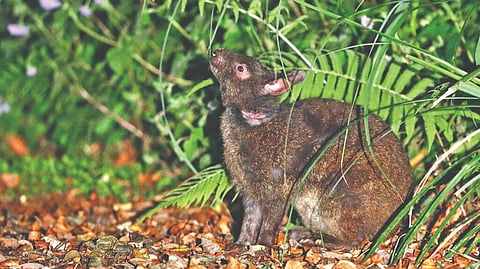

By Jason Bittel
NEW YORK: On the Amami Islands of Japan, wonder blooms from a nibble and some droppings. In February 2020, an amateur naturalist named Yohei Tashiro was walking through the evergreen forests of the islands, situated about halfway between mainland Japan and Taiwan.
On the ground, nestled against the roots of a tree, he noticed a cluster of strange, red globes — like strawberries crossed with red cap mushrooms. Even more interesting: Something clearly had been going to town on the ruby-red growths, the fruits of a weird little plant called Balanophora yuwanensis.
A plant oddity, B. yuwanensis does not perform photosynthesis, but rather leaches its energy from the roots of other plants. Technically, it’s a parasite.
While scientists had long figured that B. yuwanensis relied on the wind to spread its seeds, dense plants growing beneath the tree canopy cut down on how much air can blow through the forest.
In addition, the plant’s seeds are tightly packed, dry and rather unappealing aside from their vibrant color.
“Yes, I tried it,” said Kenji Suetsugu, an ecologist at Kobe University in Japan, “but it was not sweet and not tasty.” Birds have been known to eat the fruits, but only sparingly, leaving the scientists to wonder: Could the parasitic plant get around by advertising its seeds to an ancient, endangered and equally weird mammal instead?
Enter the nocturnal Pentalagus furnessi, or Amami rabbit, the world’s only dark-furred wild bunny. In a study published this week in the journal Ecology, Dr. Suetsugu and Hiromu Hashiwaki, a co-author also of Kobe University, posit an evolutionary bargain between Amami rabbits and B. yuwanensis.
The root-sucking plants give food in exchange for seed dispersal services — something that has never been documented between a mammal and a parasitic plant.
The five-pound Amami rabbits are sometimes called “living fossils” because their ancestors have died out on mainland China. But on two small, volcanic islands known as Oshima Island and Tokunoshima Island, about 5,000 of the short-eared bunnies soldier on.
The International Union for Conservation of Nature considers the species endangered, a result of a combined habitat about 130 square miles, and the ever-present threat of annihilation by non-native predators on the islands, including mongooses, cats and dogs as well as logging operations by humans.
Amami rabbits hold cultural significance to the people who live on these islands and they are a flagship species for conservation and tourism. But not a lot is known about them, Dr. Suetsugu said.
Acting on a hunch that it was the rabbits gnawing the fruits to their nubs, the scientists trained three infrared camera traps on B. yuwanensis fruit bundles in January 2021.
By March, they had an answer. During the day, pale thrushes and Ryukyu robins visited the bright red fruits, but the birds tended to consume only a little bit of fruit at a time. Invasive rats also infrequently dined on the fruits.
But when night fell, the Amami rabbits feasted, sometimes gobbling up a whole, golf-ball-sized globe in a single sitting.
Combining the frequency of visits and the amount of fruit consumed, the scientists concluded that the rabbits were the main creatures feeding on the parasitic plants.
The study reveals yet another complex relationship that has evolved through the ages, said Dr. Suetsugu. It also hints at the greater toll incurred when we drive species to extinction.
He added: “The loss of the Amami rabbit could also have a ripple effect on the entire ecosystem.” All the more reason to study the Amamis before they’re gone.
Visit news.dtnext.in to explore our interactive epaper!
Download the DT Next app for more exciting features!
Click here for iOS
Click here for Android